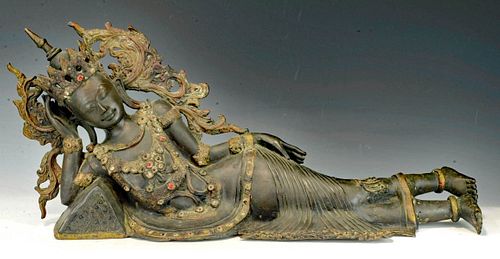19th C. Burmese Gilt Bronze Reclining Buddha
Lot 122c
About Seller
Artemis Fine Arts
686 S Taylor Ave, Ste 106
Louisville, CO 80027
United States
Selling antiquities, ancient and ethnographic art online since 1993, Artemis Gallery specializes in Classical Antiquities (Egyptian, Greek, Roman, Near Eastern), Asian, Pre-Columbian, African / Tribal / Oceanographic art. Our extensive inventory includes pottery, stone, metal, wood, glass and textil...Read more
Categories
Estimate:
$4,000 - $6,000
Absentee vs Live bid
Two ways to bid:
- Leave a max absentee bid and the platform will bid on your behalf up to your maximum bid during the live auction.
- Bid live during the auction and your bids will be submitted real-time to the auctioneer.
Bid Increments
| Price | Bid Increment |
|---|---|
| $0 | $25 |
| $300 | $50 |
| $1,000 | $100 |
| $2,000 | $250 |
| $5,000 | $500 |
| $10,000 | $1,000 |
| $20,000 | $2,500 |
| $50,000 | $5,000 |
| $100,000 | $10,000 |
| $200,000 | $20,000 |
About Auction
By Artemis Fine Arts
Oct 7, 2021
Set Reminder
2021-10-07 10:00:00
2021-10-07 10:00:00
America/New_York
Bidsquare
Bidsquare : Exceptional Antiquities Ethnographic Fine Art
https://www.bidsquare.com/auctions/artemis-gallery/exceptional-antiquities-ethnographic-fine-art-7537
Museum-worthy examples of Egyptian, Greek, Roman, Etruscan, Near Eastern, Far East / Asian, Pre-Columbian, African / Tribal, Oceanic, Native American, Spanish Colonial, Fossils, Ancient Jewelry, Fine / Visual Arts, so much more! Artemis Fine Arts info@artemisfinearts.com
Museum-worthy examples of Egyptian, Greek, Roman, Etruscan, Near Eastern, Far East / Asian, Pre-Columbian, African / Tribal, Oceanic, Native American, Spanish Colonial, Fossils, Ancient Jewelry, Fine / Visual Arts, so much more! Artemis Fine Arts info@artemisfinearts.com
- Lot Description
Southeast Asia, Burma (present-day Myanmar), Mandalay Period, ca. 19th century CE. An impressive bronze Buddha with lustrous, gilt details, depicted in a pose known as the lion's pose or parinirvana - reclining to his right side with his head supported by his right arm as his left arm rests on his side. Here the tranquil deity is shown as a prince, in splendid robes and a huge, elaborate headdress. His visage is calm and gentle, exuding serenity and peace. Long-lobed ears flank his face acting as a dual symbol of his renunciation of worldly possessions, as his earlobes were stretched by the lavish jewels which adorned them before he gained enlightenment, and his compassion, as it said the enlightened one can hear the cries of suffering throughout the world. Size: 27" L x 13" H (68.6 cm x 33 cm)
In Burma, Mandalay is regarded as the center of Buddhism, and consequently art flourished in this region, and it became known as the center of pure art of Myanmar. The artists employed advanced techniques to create a sophisticated style. This example possesses characteristic traits of the Mandalay Buddha with its emphasis in realism in his slender body and detailed clothing, as well as his lack of a pedestal as these figures were made originally to be placed in the center of decorative niches or archways.
Buddhas can display various mudras (hand gestures/poses) that represent historical moments in Buddha's life, forms of meditation, or a symbolic combination of both. As mentioned previously, this Buddha displays the parinirvana. The term "parinirvana" literally means "nirvana following death" and is used to describe a state achieved upon death by an individual who has rightfully attained nirvana. This piece most likely depicts the Parinirvana of Buddha Shakyamuni. According to tradition, after he ate his last meal offered by a blacksmith named Cunda, Shakyamuni grew seriously ill and in time abandoned his earthly existence in the village known as Pava, surrounded by his disciples and attendants. Statues of the Buddha in parinirvana, such as this one, are not intended to induce fear or sadness, but instead act as an object of encouragement that all beings have the potential to be awakened or enlightened and release themselves from the suffering which is characterized by the cycle of rebirth. An impressive example of Buddhist visual culture, replete with immense artistry and numerous layers of meaning. A breathtaking symbol of peace, representing wisdom, balance, generosity, and compassion.
This piece has been searched against the Art Loss Register database and has been cleared. The Art Loss Register maintains the world's largest database of stolen art, collectibles, and antiques.
Provenance: private New York, New York, USA collection
All items legal to buy/sell under U.S. Statute covering cultural patrimony Code 2600, CHAPTER 14, and are guaranteed to be as described or your money back.
A Certificate of Authenticity will accompany all winning bids.
PLEASE NOTE: Due to recent increases of shipments being seized by Australian & German customs (even for items with pre-UNESCO provenance), we will no longer ship most antiquities and ancient Chinese art to Australia & Germany. For categories of items that are acceptable to ship to Australia or Germany, please contact us directly or work with your local customs brokerage firm.
Display stands not described as included/custom in the item description are for photography purposes only and will not be included with the item upon shipping.
#167973Excellent condition with deep patina.Condition
- Shipping Info
-
All shipping is handled in-house for your convenience. Your invoice from Artemis Gallery will include shipping calculation instructions. If in doubt, please inquire BEFORE bidding for estimated shipping costs for individual items.
-
- Buyer's Premium



 EUR
EUR CAD
CAD AUD
AUD GBP
GBP MXN
MXN HKD
HKD CNY
CNY MYR
MYR SEK
SEK SGD
SGD CHF
CHF THB
THB




















